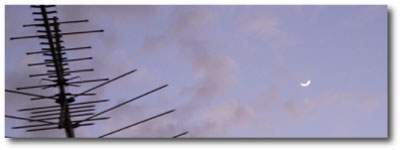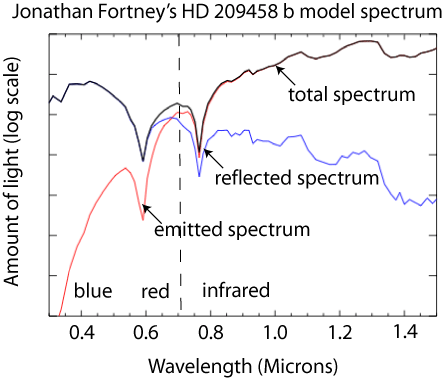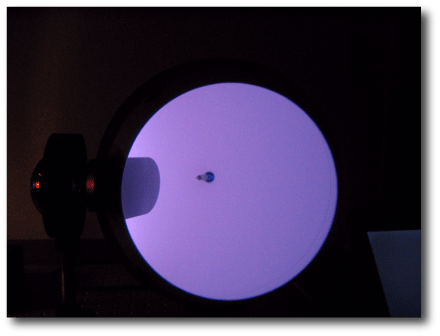
I’ve often wondered what the dayside of a Hot Jupiter would look like (with the dark, wraparound shades on, of course).
Jonathan Fortney and his collaborators at NASA Ames Research Center have been making sophisticated calculations to determine the atmospheric structures of giant planets. As a product of this research, they can compute a prediction of what the spectrum of the light coming from a short-period giant planet should be. For example, for HD 209458 b, they get the following distribution of light coming off of the planet:

If we look at the dayside (substellar point) of the planet, the total distribution of light that we would see in this model is given by the solid black curve. This total light is a sum of the light that the planet reflects (the blue line) and the light that is actually generated by the hot planet itself (the red line). As one would expect, the visible-light dayside appearance of the planet is dominated by the reflected light. The nightside image is considerably les bright, and its somewhat battered thermal spectrum is a bit more magenta than the Oklo splash image, (which was generated with a black-body color map).
Molecular absorption due largely to water and methane selectively removes yellow and green light from the reflected optical spectrum. This suggests that the hot Jupiter daysides should have some sort of purplish appearance. But what exactly will the color look like?
John Moores, a graduate student at the University of Arizona, and his advisor, Peter Smith, the PI of the Phoenix Mars Lander have built an optical setup which can generate (in an integrating sphere) the composite color that corresponds to any pre-specified optical spectrum. [Moores’ weblog is here]. Their goal is to obtain a source that simulates the Martian lighting environment. Given the distinctly unearthly cast to the Martian illumination, it’s of interest to see whether long-duration exposure leads to adverse psychological or even physiological effects.
Moore used Fortney’s spectrum as an input to his apparatus to produce the image below. It shows the integrating sphere bathed in the resultant color. There is a small hole cut in the back of the sphere to allow access to a fiber spectrometer (visible as a dark spot to the left of center).

To the best of our knowledge, therefore, the daysides of hot Jupiters are imbued with distinctly trendy distinctly mauve-like hues.
